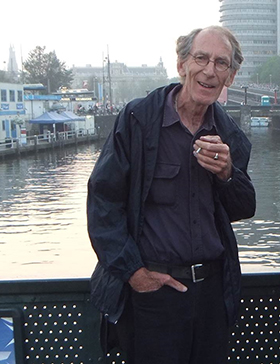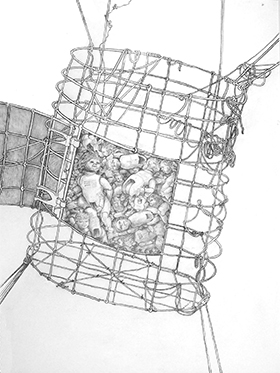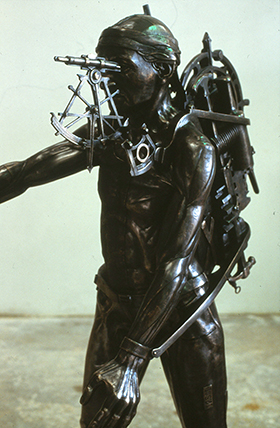 Hans Arkeveld in Europe
Hans Arkeveld in Europe
Hans Arkeveld
December 2013
My purpose for visiting Florence was to see the La Specola collection of wax anatomical models. In 1771 a ceroplastic studio was set up at the back of the Pitti Palace to be part of a natural history museum. There, absolutely stunning life-sized models, made using coloured wax, are exhibited. The modelling skills and anatomical knowledge was truly awesome. It was hard to believe that what I was looking at was made 240 years ago. Afterwards, we walked through the beautiful gardens behind the Pitti Palace in the warm, Italian sun.
Five of my friends work, or have worked, in marble – two have died, one became a writer and two still carve. All have at some time travelled to Carrara to select their stone. They carved them in the stone-carving workshops in the town of Pietrasanta. They would talk about this place with affection – about stone-workers yards with tin sheds and awnings, some real buildings; blocks of stone finished and unfinished; jibs and block and tackle – noisy and dusty – but a hive of activity, with sculptors from all over the world. Because of their stories and fond memories about Pietrasanta, I have always wanted to visit there. We took the opportunity to go, and found some of the workshops. Whoever we approached happily stopped and showed us his or her work. I felt quite humbled by their commitment to their work and the skills they had acquired over many years of carving. La Specola and Pietrasanta are still two highlights of our trip.
After Florence, we took the fast train to Padua. This visit was to see the oldest dissection theatre and medical university in Europe. This was the first place where human cadavers were legally dissected for medical research – quite astonishing in a land overshadowed by the all-powerful Catholic Church. We found our way to the Medical School at the University and asked if we could view and draw some of their specimens. The initial response was one of suspicion, but after ‘Googling’ us, they introduced us to the librarian, who showed us some very large volumes containing amazing, finely engraved, anatomical prints. Even though the librarian could not speak English, our enthusiastic response to seeing these stunning prints made her rattle off in Italian about them. We later had a lady interpret that the librarian wished more people would show such enthusiasm as they are so infrequently viewed. Before departing, we were asked to sign a letter acknowledging our visit, which they were going to display at the library.
 In Berlin we visited the Humboldt University Medical School where we found a stunning anatomical collection, housed in large glass vitrines. This collection contained the most variable specimens and models (up to 200 years old) that I have ever seen in one space; and reminded me of the Frederik Ruysch collection, purchased from the Dutch by Peter the Great of Russia (now housed in the Hermitage). The models seemed to be made of a variety of materials, including wood, wax, papier-mâché, plaster and polymer. There were some stunning corrosion casts and numerous foetal defects and atrophy, some embryological models from the Zeigler studio, and some extraordinary fine detail dissections from cadavers, very clearly preserved.
In Berlin we visited the Humboldt University Medical School where we found a stunning anatomical collection, housed in large glass vitrines. This collection contained the most variable specimens and models (up to 200 years old) that I have ever seen in one space; and reminded me of the Frederik Ruysch collection, purchased from the Dutch by Peter the Great of Russia (now housed in the Hermitage). The models seemed to be made of a variety of materials, including wood, wax, papier-mâché, plaster and polymer. There were some stunning corrosion casts and numerous foetal defects and atrophy, some embryological models from the Zeigler studio, and some extraordinary fine detail dissections from cadavers, very clearly preserved.
Amsterdam was a short stopover for a few days. Although a haven for tourists, being on Dutch soil, I felt at home. We took the opportunity to visit my birthplace and home, until my family migrated to Australia in 1952, in Scheveningen. I also have a close friend there who is a marble carver (one of those who had worked at Pietrasanta), whom we went to visit at his home and studio. This became a nostalgic and sentimental journey for me, especially when we left Holland on an overnight boat to Newcastle from the same departure point as I left on a misty day in 1952, thinking that I may never see it again.
From Newcastle we made our way by train and bus to Minard, Loch Fyne in northwest Scotland. Dr Richard Dryden is an embryologist and I had hoped to do some small experimental projects under his guidance. There was much to do to complete some diagrams and drawings for a book that we have been working on together. This book is a story told from a blood cell’s experience of travelling through a developing embryo.
Scotland was the last stop of my journey. I look back and I think what a wonderful and beneficial experience the whole trip was. There were a few things that really stood out for me, like the wax anatomical models from La Specola.
 The dissected cadavers in Berlin not only left a clear indication of the isolated tissues and deeper structures of certain parts of the anatomy, but they also unintentionally left an impression of design – a harmony of form, a beautifully proportioned and balance of parts. This is something that is never mentioned, and probably is never contemplated when dissecting. To me, this was a revelation, far beyond the expectation of the purpose of dissection and it has opened my eyes to looking closer at the dissections that I have available to me, and to combine the design within my own modelling and drawing, with the design of human anatomy in mind. It has made me realise that I have done part of this myself, subconsciously – I have emphasised or focused on certain areas more than others to make a visually balanced composition. But … how to give it an identity? I ask myself – why is it that in a room full of dissections, there are some that reflect a celebration of life, while others reflect a cold cadaver, dissected? How could an awareness of this, affect or benefit those that do the dissections? What is it that makes the difference? That difference is so subtle – almost elusive and undetectable.
The dissected cadavers in Berlin not only left a clear indication of the isolated tissues and deeper structures of certain parts of the anatomy, but they also unintentionally left an impression of design – a harmony of form, a beautifully proportioned and balance of parts. This is something that is never mentioned, and probably is never contemplated when dissecting. To me, this was a revelation, far beyond the expectation of the purpose of dissection and it has opened my eyes to looking closer at the dissections that I have available to me, and to combine the design within my own modelling and drawing, with the design of human anatomy in mind. It has made me realise that I have done part of this myself, subconsciously – I have emphasised or focused on certain areas more than others to make a visually balanced composition. But … how to give it an identity? I ask myself – why is it that in a room full of dissections, there are some that reflect a celebration of life, while others reflect a cold cadaver, dissected? How could an awareness of this, affect or benefit those that do the dissections? What is it that makes the difference? That difference is so subtle – almost elusive and undetectable.
In this era people are using more digital means to visually express human anatomy (photography, 3D plotters, etc). It has made me understand that most of these earlier models that I saw have gone beyond that. The makers have achieved something that cannot be achieved digitally or mechanically. Their models are more visually captivating. This has made me want to explore more about what makes the dissections that I draw and/or model, show parts of a human being who was once alive, felt things and had a soul, rather than a cadaver that is lifeless. My belief is that this forms the basis of our ethics in terms of our treatment of the deceased, especially when it comes to using cadavers for medical studies and organ transfers.
Art and science were once inseparable and have now become very separate disciplines. There have been token gestures to bring them closer together again, in mostly superficial ways – focusing on high tech imaging, devoid of actual drawing and modelling. I believe that my contribution from what I have seen will be discussions with students of both disciplines, about basic drawing and modelling skills, to be able to create these elusive subtleties that I have mentioned.
I am extremely grateful to Artsource for having supported me in giving me the Go Anywhere residency to make this indelible trip.
Hans Arkeveld was the recipient of a 2013 Artsource Go Anywhere residency, generously funded by the Artsource Patrons. He is also an Artsource Lifetime Achievement Award recipient.
This article featured in the Artsource Newsletter, Summer 2013/2014.
Artsource supports the practice of professional artists with the Global City Residencies.